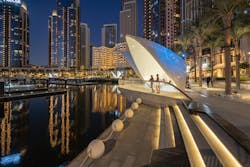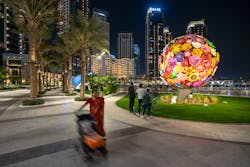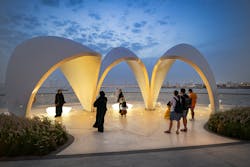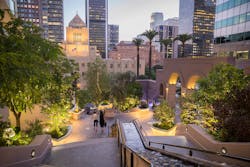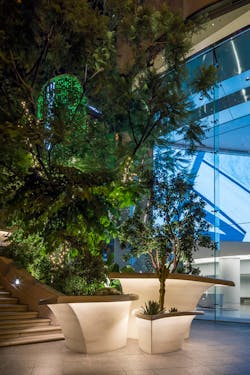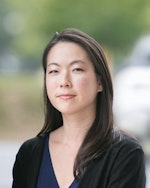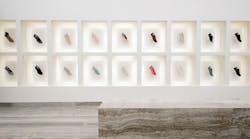Like many architecture students, Spurthy Yogananda had no idea lighting design was a field of study, much less a thriving profession. Though lighting designers comprise a smaller subset in the building sector than architects and interior designers, their role cannot be overstated. Lighting can make or break a work of architecture.
For Yogananda, the ability to shape the user experience, aesthetic impact, and energy efficiency of a project was appealing. Today, a decade after she left India to pursue a master’s degree in building science at the University of Southern California School of Architecture, Yogananda is a professional lighting designer at the Los Angeles office of HLB Lighting Design.
Here, Yogananda shares her experience as an emerging lighting designer and her advice for lighting mentors and mentees.
ArchSSL: What drew you to architectural lighting?
Yogananda: During my master’s program, I was a teaching assistant for [adjunct assistant professor] Lauren Dandridge. Until then, I had no idea what lighting design was. The way she spoke so passionately about it got me interested, and I realized how lighting is such a beautiful combination of sustainability and design.
I took her lighting design class as one of my [electives], and then I really fell in love with the field. Teachers can make a huge difference in your life.
What surprised you as you began to study lighting formally and then entered the profession?
Where I come from, lighting design is integrated with our architecture studio. It’s not a profession by itself. Seeing how much lighting can vary, and how much planning and involvement with codes is required to get to execution—that was mind-blowing.
One day, we are designing parks; the next, a hospital or a school. Each project is so different, and each has its own requirements and challenges, and I found that to be intriguing. As an emerging lighting designer, I understood that it’s not my job just to light the space, but to make sure the design is sustainable and does justice to the designer’s vision, especially at night.
What would you like to see change in the profession?
We’re always constricted with budget, and that’s a struggle for me. I’m learning to balance design and budget. You can go through the whole design process, send the [documents] to construction for bids, and then [discover] your whole fixture [schedule] is [value-engineered out]. And all your effort is gone.
A lot of thought goes into designing and choosing the fixtures, but sometimes it doesn’t turn out like we originally envisioned, and that can be disappointing. But that’s often the reality, and I am learning ways to help make sure our designs bring the best value possible.
What should emerging designers ask of their mentors?
A mentor who can help emerging designers navigate their early professional stages can be quite beneficial. It’s crucial to be clear about what you want to get out of the mentoring relationship when asking for advice from a mentor. Mentors can help with design and inspiration, but [they also can offer] a level of emotional intelligence that can be helpful as you go through other aspects of your career.
I ask my mentor, “How can I improve? What can I do better? What is the current trend? How can I keep up? What can I do from my end to help HLB—and myself—grow?” Our mentors [at the firm] make it easy for us to ask these questions. There are good and bad days, and particularly on my bad days, I find that speaking with my mentors can be refreshing and inspiring.
What can mentors expect of their mentees?
As a mentor, you want your mentees to be curious and open to learning. They should always look to grow their skill set and knowledge of design. Mentees should be proactive and able to adapt to different situations. Asking questions is a great way to learn and be proactive. No question is a dumb question, but having interest and taking the initiative to ask questions shows us that they are curious. That encourages us to teach more.
Describe a few of your favorite projects that you’ve worked on and your role in them.
Dubai Creek Harbor, which we worked on with SWA Architects, is in an iconic place in Dubai. This project is a large, mixed-use complex located on the banks overlooking Burj Khalifa. We were tasked with illuminating a marina, a boulevard, and sikkas—parklike corridors that connect the boulevard and the harbor. We illuminated them in a personal, human-scale manner with a focus on accentuating landscape features. The walkway is broken up by a variety of dynamic, enormous, suspended public artworks, each one beautifully lit to improve the viewer experience.
We knew that the residents of the area were looking for serenity in nature, the verve of innovation and eclectic cultural offerings, so it was important that we worked closely with our client to make sure the lighting conveyed these elements. Walking through our design process ensured that the result considered the end users. It was a fun challenge learning the cultural preferences of the area and considering them during design.
UCLA Graduate School of Art was a different experience for me because it was not just [an academic space]. It had a ceramics studio and a woodshop; each had different requirements. At the same time, we had to incorporate daylighting. The facility has huge skylight openings. During the day, it’s well lit, but how do you create the same environment at night?
[The client] wanted to include more industrial-looking fixtures to integrate with the industrial design of the building. Finding an aesthetically pleasing industrial fixture that can perform to the required light levels was a challenge in itself, but we were able to find the perfect fit in the end.
The Bunker Hill Steps is a small project, but iconic to L.A. We worked on the redevelopment of the landscape surrounding the stairs and the addition of lights in monumental planter pots. The light sources are concealed, lending mystery even viewed from a distance below. The lighting leads tourists along but takes care not to block views of the spectacular L.A. skyline. I learned how to delicately incorporate lighting within the given conditions, as well as the importance of details.
If someone—an architect, designer, or student—is interested in architectural lighting, what should they do?
Internships are great because you get to learn about the lighting industry and the culture of a firm before fully committing to anything. At HLB, we welcome students who want to come and have a casual chat or look at our work.
Are you involved in industry associations, and do you find it helpful?
I am involved in the International Association of Lighting Designers (IALD). We learn so much when you meet people from elsewhere at events like IALD conferences or emerging professional events. It’s inspiring and a great place to network. I get to know a lot of clients and electrical engineers. It’s nice when you put a face on someone you’ve worked on projects with. Then people understand how you are and working together becomes easier. I highly recommend that designers go.
This interview has been edited and condensed for clarity. An excerpt of this interview appeared in the Spring/Summer 2023 issue of Architectural SSL.

